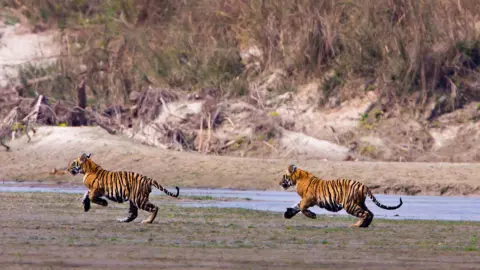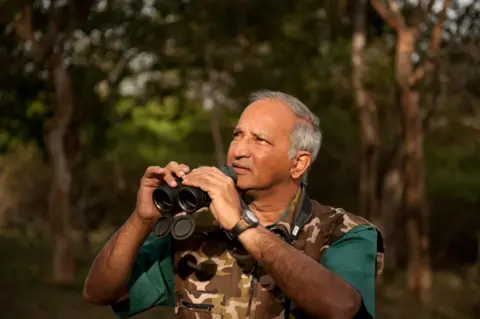 Getty Images
Getty ImagesNepal is being celebrated globally for tripling its tiger population in a decade, but Prime Minister KP Sharma Oli believes the country may be too successful.
"In such a small country, we have over 350 tigers... We cannot have so many tigers and then have them eat humans," he said last month at an event organized to review the country's COP29 results.
Tiger attacks killed nearly 40 people and injured 15 others between 2019 and 2023, according to government data. But local communities say the number is much higher.
"For us, 150 tigers are enough," Oli declared in December. He even suggested that Nepal could give its prized big cats as gifts to other countries.
How many tigers are too many?
Experts say there is no one answer. It depends on the availability of prey in a given area - ideally, each tiger should be surrounded by about 500 prey, such as deer, antelope or wild buffalo, says tiger biologist Ullas Karanth .
Experts believe Oli's concerns about limiting tiger numbers are misplaced. Instead, the Nepalese government should focus on “expanding protected areas with reasonable natural densities of game and tigers,” Dr. Karanth added.
If wild animals are fleeing protected areas in search of prey, this may explain why so many attacks occur at forest borders, where tigers always encounter humans.
One example is the "buffer zone" located between national parks and human settlements. Wildlife is often seen here, but locals also use the area to graze cattle and collect fodder and firewood.
Forest corridors – strips of land that connect different parks and biological reserves, allowing wildlife to roam between them – have become another hotspot. Sometimes roads pass through these areas and locals use them for foraging, making them vulnerable to attack.
Zoologist Karan Shah said the rising human death toll showed Nepal's once-successful conservation model was collapsing.
 Getty Images
Getty Images"So far, (Nepal's) focus seems to be on gaining international attention, while neglecting the impact on communities surrounding national parks and protected areas," Mr Shah added.
He believes that conservation is not just "an ecological or scientific issue" but also a social issue, and that casualties must be prevented so that local communities continue to be involved in conservation efforts rather than against it. Anger among locals is also growing as tigers prey on livestock.
"A large portion of our population still lives in rural areas and depends on the forest resources they help protect, but now more and more people are being hunted by tigers," said Thakur Bhandari, president of the Nepal Federation of Community Forestry Users. Killed or injured" BBC.
"As forest conservationists, we can't be against wildlife, but that doesn't mean we should ignore its impact on people and society."
A success story turned deadly
A century ago, there were about 100,000 tigers in Asia, but deforestation and rampant poaching have pushed them to the brink of extinction. Currently, there are only about 5,600 wild tigers left in 13 countries including Nepal, China, India, Thailand, Indonesia and Russia.
All of these countries have committed to doubling tiger numbers by 2022, but Nepal is the first to exceed that target, thanks in part to zero-poaching initiatives and an increase in forest cover between 1992 and 2016. times.
Forest corridors linking 16 protected areas in southern Nepal to India's northern border areas also play a role.
A growing number of tiger attacks now tarnish that achievement.
Oli believes that the growth of tiger numbers in Nepal comes at the cost of human lives. However, workable solutions are not readily available.
The Parks and Wildlife Department acknowledges the challenges of managing tigers in Nepal, with those that kill humans being tracked and kept in captivity.
"Zoos and rescue centers are already overwhelmed with problem tigers," the department said in a conservation report released in 2023. "There is an urgent need to develop a comprehensive program to address the rescue, handling and rehabilitation of problem animals."
 Ullas Kalans
Ullas KalansOli proposed sending Nepal’s tigers abroad.
“People like to keep birds like falcons and peacocks as pets, so why not tigers?” he suggested. "It will also enhance their status."
Others have different ideas.
Dr Karanth said tigers that have repeatedly claimed human lives should be "killed immediately". Some believe humans are exacerbating the problem by intruding into tigers' natural habitats, using the land for farming or infrastructure and reducing the big cats' prey base.
Meanwhile, the BBC spoke to a wildlife management expert who claimed Oli wanted to reduce tiger numbers so more land could be cleared for infrastructure.
"This has nothing to do with people's safety," he said.
The situation is currently at a stalemate. It's unclear whether Oli's "tiger diplomacy" proposals will gain traction, or whether excessive human or tiger intrusion is to blame for Nepal's tiger attack crisis.
It's clear that humans and tigers are struggling to coexist peacefully in Nepal, and the country's conservation success story raises many thorny issues that need to be addressed.
